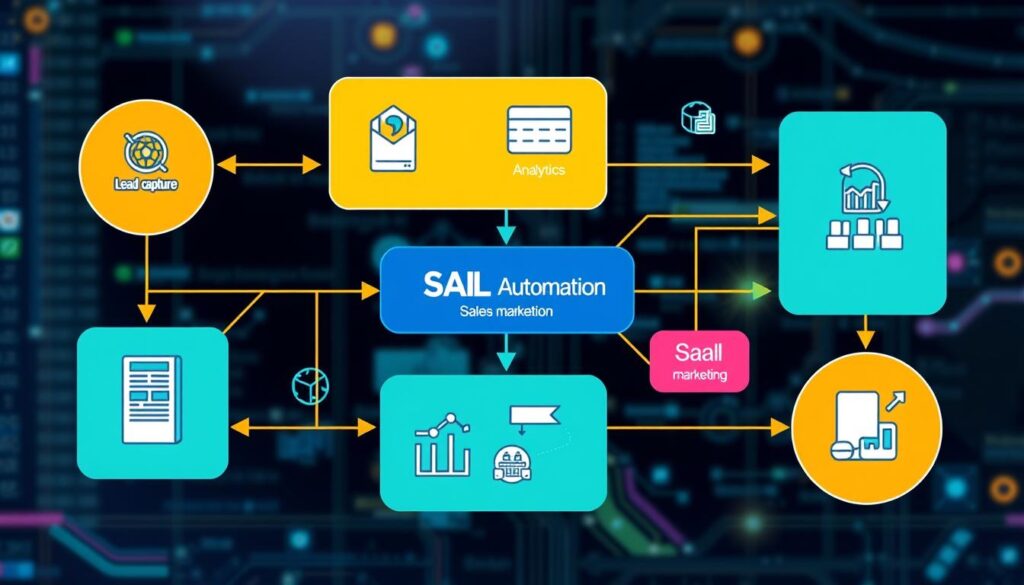The business world is always changing. Because of this, it is key to automate sales and lead generation processes. Organizations that are ahead of the curve use sales automation to boost sales efficiency. They create automated sales funnels that work well with little need for people. Tech consultants provide expert solutions. They help businesses use new tools to change how they connect with customers and make sales.
Having a good automated system is crucial for consistently finding new leads. This allows companies to grow and increase their income, even as the market changes.
Key Takeaways
- Leverage technology to create a seamless automated sales funnel for enhanced efficiency.
- Implement automate sales and lead generation processes to minimize manual efforts and errors.
- Utilize automation solutions to allocate more resources towards strategic endeavors.
- Embrace sales automation for a scalable and responsive sales strategy contributing to business growth.
- Adopt systems that populate sales funnels around the clock, maximizing lead conversion opportunities.
The Importance of Automating Sales Processes
In today’s business world, sales automation is crucial. It helps companies make their lead generation and sales processes faster. By adopting sales automation technologies, businesses can work more efficiently and generate leads better.
Understanding Automation in Sales
Automation in sales means using software to do regular sales tasks on its own. This includes everything from finding leads to helping them become customers. With this technology, salespeople can spend more time making sales instead of doing paperwork. About a third of sales tasks can now be automated, showing how technology can change sales roles.
Benefits of Sales Automation
Companies that use sales lead automation see big benefits. One advantage is faster order processing, which can now take hours instead of days. This can make sales teams 20% more efficient, as they have more time to sell. Automating also makes companies 10 to 15% more efficient and can increase sales by up to 10%. Plus, it makes customers happier by making their after-sales experience better.
Key Metrics to Consider
To know how well sales automation works, businesses look at different important measures. They pay attention to how good the leads are, how many leads buy something, and how fast leads become customers. Automated tools for engaging with potential customers also help companies predict and analyze their sales. This means companies can make better sales and marketing plans based on data.
| Metric | Impact on Automation |
|---|---|
| Lead Quality & Conversion Rates | Enhanced by automated lead scoring and nurturing |
| Efficiency Gains | 10-15% improvements reported |
| Sales Uplift Potential | Up to 10% increase |
| Reduction in Order Processing Time | Decreases from days to hours |
| Increase in Selling Time | 15-20% more time for sales activities |
By using sales automation, businesses can do their work better and grow faster. This makes it a key part of today’s sales strategies.
Components of an Effective Lead Generation Strategy
An effective lead generation strategy is vital for B2B campaign success. To truly optimize lead generation, businesses need to understand and implement key components. Doing so can greatly improve their marketing efforts.
Content Marketing for Leads
Content marketing is central to improving your lead generation strategy. It uses different content types to attract and engage prospects. Since over half of qualified leads are not ready to buy at first, creating engaging and educational content is essential. This content, ranging from blog posts to guides, helps address buyer concerns. It also guides them closer to making a purchase.
Email Marketing Automation
Email marketing is a top way to keep in touch with leads. With automated emails, you can send messages tailored to user actions and interest. This makes communication more timely and relevant. Personalized emails also greatly boost your chances of converting leads. Check out this automation for more info.
Utilizing Social Media for Lead Generation
Social media lets brands interact with their audience directly. Using lead generation automation tools, companies can post content, manage ads, and track user interactions on platforms like Facebook and LinkedIn. These steps are key for promoting your brand and effective lead generation strategy. A consistent online presence helps attract potential leads and build profitable relationships.
Creating a strong lead generation strategy enhances marketing efficiency and boosts business growth, helping companies achieve their targets.
| Lead Generation Component | Percentage of Impact | Tools/Practices Used |
|---|---|---|
| Content Marketing | 50% | Blogs, Ebooks, Webinars |
| Email Marketing Automation | 30% | Automated Campaigns, Personalization |
| Social Media | 20% | Scheduling tools, Interactive posts |
Tools for Automating Sales and Lead Generation
In our digital world today, using automation for optimizing lead generation is crucial. Businesses are adopting tools to improve their lead generation strategy and automate sales processes. These tools help them stay ahead and work more efficiently.
CRM Solutions
CRM software is key for sales automation. Systems like HubSpot and Pipedrive help manage lead info well. They make outreach personalized and efficient. Integrating with email and social media, they create a unified sales environment.
Email Automation Tools
Email tools like Mailchimp and Saleshandy are essential for sales automation. They automate emailing, saving time and improving target accuracy. With analytics, companies can see if their strategies work and adjust to get better results.
Chatbots and AI Assistants
AI assistants and chatbots answer questions quickly, helping users and collecting data. Available on sites and social media, they offer constant help. They’re key for 24/7 service and making leads feel valued.
Using these tools smartly can give you an edge and help grow your business. For deeper insights, check out lead generation tools. This review details how to streamline sales processes effectively.
| Tool | Rating (Out of 5) | Key Features |
|---|---|---|
| Skylead | 4.8 | Connection requests, B2B database access |
| OptinMonster | 4.3 | Exit-intent technology, lead capture forms |
| Moosend | 4.6 | Email marketing automation, personalized campaigns |
| Mailchimp | 4.4 | Email builder, drip campaigns, analytics |
| Tidio | 4.7 | Chatbots, live chat integration |
Setting Up an Automation Workflow
Creating a smooth workflow for automated sales and leads is key to better sales and more leads. It’s important to know how to set up these processes to boost a sales team’s work. This can make the team more productive and efficient.
Mapping Out Your Sales Process
The first step in setting up sales automation is to map out each part of the sales journey. This goes from when a lead is first found to when a sale is made. Each step must be clear.
This allows companies to see which tasks take a lot of work. These tasks can then be automated. This helps the sales team and keeps things running smoothly.
Integrating Automation Tools
Finding and using the right tools is crucial for automating sales steps. Tools like CRM systems and email marketing can work together well. Saleshandy, for example, offers a great B2B database and ways to filter prospects accurately. Using these tools makes managing and nurturing leads better and more efficient.
Testing Your Workflow
After adding automation tools, it’s important to test everything. Making sure everything works as expected is key. Keep an eye on how leads are doing and how they interact. Regular tests and updates make the sales steps better. They help it keep up with new market trends and tech.

Automating sales and leads saves time, improves lead quality, and increases sales. By setting up, integrating, and testing your sales steps carefully, your business can work more smoothly. This also helps you meet the needs of potential customers better.
| Feature | Benefits |
|---|---|
| Automated CRM entries | Reduction in data entry errors and time |
| Lead Scoring Automation | Focus on high-potential leads, enhancing conversion rates |
| Automated Nurturing Campaigns | Consistent engagement, improving lead retention |
As sales get more complex, being able to make sales steps smoother is very valuable. Using sales automation tools to the fullest can save resources. It also helps build stronger relations with customers and grows the business.
Best Practices for Maintaining Automation Systems
For any business, effective automation systems are crucial. They help optimize the strategy for generating leads. They also automate sales and the process of generating leads. Keeping these systems well-maintained boosts efficiency. It also ensures success and growth in sales automation solutions over time. Here are ways to keep systems running smoothly:
Regularly Updating Automation Tools
Technology changes fast, and so should our lead generation and sales tools. This means always using the newest software. It also means adding new features that make the system better. To avoid problems and stay ahead, companies need to update their tools often.
Training Your Sales Team
Training the sales team regularly is key to better lead generation. Understanding the latest tools boosts productivity and customer experience. Good training lets everyone use tech like CRM systems to build strong customer relationships.
Monitoring and Analyzing Performance
It’s vital to keep an eye on how automation systems for sales and lead generation are doing. Looking at metrics like lead quality tells us a lot. This ongoing check helps adjust strategies to get better marketing and sales results.
| Statistic | Detail |
|---|---|
| Global Marketing Automation Growth (2021-2024) | 38.2% increase, reaching $6.62 billion |
| AI and Automation Tool Usage by Marketers (2024) | 64% |
| Buyer Preference for Goal Alignment | 84% prefer companies that align with their goals |
Maintaining automation isn’t just about the tools. It’s also creating a culture of learning, watching, and tweaking. This approach helps companies grow in a meaningful and lasting way with automation.
Overcoming Common Obstacles in Automation
To effectively automate sales and lead generation, businesses face challenges like resistance and technical issues. Overcoming these hurdles not only makes sales processes smoother but also improves lead generation. This boosts overall sales efficiency.
Addressing Resistance to Change
Change management is key for sales lead automation. Many employees stick to old ways and might resist new systems. To lower resistance, showing the clear benefits of automation through education and support is critical. Highlighting how automation saves time and reduces errors can win their backing.
Budget Constraints
Though initially costly, lead generation automation systems promise significant long-term savings. Decision-makers need to see the ROI these technologies offer over old methods. Explaining the potential for lower labor costs and better lead conversion rates could help in getting funds.
Technical Challenges
Introducing new automation technologies can bring problems like software compatibility and integration issues. Opting for platforms known for easy integration and having an expert IT team for support can ease these concerns. It’s also wise to choose platforms with excellent customer support and positive reviews.
| Statistic | Impact |
|---|---|
| 51% of sales professionals struggle with lead generation | High demand for better lead generation tools |
| 37% of sales professionals do not use automation | Potential market for introducing automation |
| 24% cite lack of suitable tools as the reason | Need for more tailored automation solutions |
| 14% more likely to meet sales targets with automation | Direct correlation between automation use and sales success |

To tackle these obstacles, a strategic plan, thorough training, and choosing flexible technologies are important. By effectively dealing with these common challenges, companies can smoothly shift to automated systems. This leads to better lead generation automation and smarter use of resources.
The Role of Data in Automation
In the world of sales automation, using data smartly is key. Companies aim to make their sales routines smoother and get more leads. It’s crucial to get, analyze, and use data right.
Sales lead automation needs good data to better connect with future customers. This part looks at data’s role in improving sales efficiency and making lead generation automatic.
Collecting Relevant Data
Getting the right data is the first step towards better lead generation. Info on customer types, behaviors, and how they interact is vital. This helps in making sales methods automatic and more tailored, resulting in better customer talks. Marketers find that using tools like Salesforce gives them a great return, thanks to careful data gathering.
Analyzing Data for Better Insights
Analyzing the data gives useful tips for action. Sales automation tools help look at a lot of data quickly. This lets companies see trends and likes in their audience. This info then guides changes in campaigns, making them fit what consumers want better and boosting sales productivity.
Utilizing Data for Targeting Strategies
Data proves its worth in sales lead automation when it’s used in real plans. Good targeting strategies, based on data, mean marketing isn’t wasted on the wrong crowd. Instead, it’s focused on leads considered valuable by analytics. Tools like AI and machine learning help spot patterns that guess buying actions, improving how leads are chosen and ranked.
By implementing sales automation and using data well, companies can predict trends, know what customers want, and enter the market more effectively. It’s not just gathering data, it’s about using it to craft sharper marketing strategies for big business growth.
Future Trends in Sales Automation and Lead Generation
The sales world is about to change a lot, thanks to AI and automation. These new tools will make selling and generating leads much more efficient. By 2025, AI will cut down time for manual tasks and give insights that boost sales big time.
The Impact of AI and Machine Learning
AI and machine learning will soon change how we find and engage with potential buyers. They’ll let us quickly spot good leads by analyzing data on buyer habits. Services like Salaria Sales are set to provide better lead qualification, personalized outreach, and smart predictions. This isn’t just future talk. Some businesses are already seeing up to 50% better lead quality and 80% less time spent on lead scoring.
Predictive Analytics in Sales
Predictive analytics is going to be a game-changer for sales automation. It looks at past data to predict which leads will do well, boosting conversion rates. By 2025, it’s expected to increase conversion rates by 10-15% by focusing on the most promising leads. This approach is making the sales process more proactive and based on solid data.
Shifts in Consumer Behavior and How to Adapt
Being adaptable is key in responding to changing consumer behavior. Using automation tools and AI gives companies an advantage. By 2025, putting a strong focus on personalization will be crucial. AI helps customize messages and offers to each prospect, saving up to 40% of the time spent on reports. This means businesses can move faster and with more accuracy in reaching consumers.
FAQ
What is sales automation and how can it enhance sales efficiency?
Sales automation uses digital tools to automate sales tasks. This automation boosts efficiency by handling repetitive tasks. It lets sales reps focus on selling and connecting with customers.
It speeds up lead qualification, follow-ups, and sales conversions. This makes the sales process smoother.
What are the main benefits of automating your sales processes?
Automating sales processes saves time and reduces mistakes. It leads to better efficiency, higher-quality leads, and the ability to grow without losing touch with customers. Automation targets leads ready to convert, raising sales productivity.
Which key metrics should businesses look at when measuring the success of sales automation?
When evaluating sales automation, look at lead quality, conversion rates, and cost efficiency. Check how fast leads move through the sales funnel too. This information helps improve automation strategies and lead nurturing efforts.
How does content marketing contribute to an effective lead generation strategy?
Content marketing creates valuable materials like blogs and guides. It draws in leads by offering them the information they prefer. This aligns with how consumers like to research on their own.
How does email marketing automation support lead generation?
Email marketing automation keeps leads engaged with automated emails. It uses personalization and behavioral triggers for consistent follow-up. This approach nurtures potential customers, boosting conversion chances.
What is the role of social media in automating lead generation processes?
Social media automation helps in scheduling content and managing ads. It engages audiences and ensures a consistent brand presence. By doing so, it boosts engagement with leads and improves lead generation.
What are CRM solutions and how do they facilitate sales and lead generation automation?
CRM solutions manage lead info, making outreach more personalized and efficient. They integrate with tools like email marketing and social media, creating a synchronized sales environment.
How do email automation tools like Saleshandy and Mailchimp assist in sales lead automation?
Email automation tools send personalized emails and measure success with analytics. Saleshandy also offers email warmup and B2B database access. These features improve deliverability and targeting.
What is the function of chatbots and AI assistants in sales automation?
Chatbots and AI assistants provide round-the-clock customer service. They engage users directly, guide them, and collect data. This improves user experience and helps in capturing and qualifying leads.
What are the first steps in setting up a sales automation workflow?
To begin, outline the sales process and decide which tasks to automate. Ensure these tasks fit well with the team’s workflow. This preparation integrates automated systems smoothly with sales operations.
What are some best practices for maintaining sales and lead generation automation systems?
Keep systems up-to-date and train your sales team on them. Monitor performance and adjust the workflow to maintain effectiveness. Testing and tweaking the system ensures it stays efficient.
How can businesses address resistance to automation among their sales teams?
Understanding sales staff concerns is crucial. Show them how automation benefits them and offer full support and training. Use change management to ease the shift to automated processes.
What role does data play in automating sales and lead generation processes?
Data is key for understanding customer behavior and refining strategies. Using insights from data helps craft targeted campaigns. This optimizes resources and boosts sales.
How are AI and machine learning expected to impact future sales automation and lead generation?
AI and machine learning will bring smarter automation, prediction tools, and better personalization. These advancements will deepen our understanding of customers, meeting their needs more effectively.
How can sales teams use predictive analytics to improve their strategies?
Predictive analytics helps foresee sales trends and customer behaviors. This enables sales teams to target the right prospects. By doing so, they can engage them proactively to enhance outcomes.
What adaptations are necessary for sales automation as consumer behavior shifts?
As consumer behavior changes, sales strategies must adapt. This means watching market trends and analyzing data. Keeping up with these changes keeps businesses competitive and responsive.



